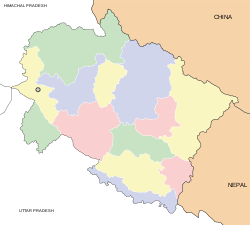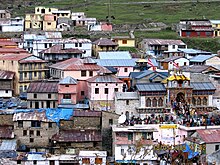Badrinath
From Wikipedia, the free encyclopedia
This article is about Badrinath town. For the temple, see Badrinath temple. For the cricketer, see Subramaniam Badrinath . For the 2011 Telugu film, see Badrinath (film).
| Free Badrinath Island dominos | |
|---|---|
| Town | |
| Badrinath Valley, along the Alaknanda River | |
| Coordinates: 30.744°N 79.493°ECoordinates: 30.744°N 79.493°E | |
| Country | India |
| State | Uttarakhand |
| District | Chamoli |
| Area | |
| • Total | 3 km2 (1 sq mi) |
| Elevation | 3,300 m (10,800 ft) |
| Population (2001) | |
| • Total | 841 |
| • Density | 280/km2 (730/sq mi) |
| Languages | |
| • Official | Hindi |
| Time zone | IST (UTC+5:30) |
Badrinath is a holy town and a nagar panchayat in Chamoli district in the state ofUttarakhand, India. It is the most important of the four sites in India's Char Dhampilgrimage and gets its name from the Holy temple of Badrinath.
Contents
[hide]Geography[edit]
Badrinath has an average elevation of 3,100 metres (10,170 feet). It is in the GarhwalHimalayas, on the banks of the Alaknanda River. The town lies between the Nar and Narayana mountain ranges 9 km east of Nilkantha peak (6,596m). Badrinath is located 62 km northwest of Nanda Devi peak and 301 km north of Rishikesh. From Gaurikund (near Kedarnath) to Badrinath by road is 233 km.
Significance[edit]
Badrinath was re-established as a major pilgrimage site by Adi Shankara in the ninth century.[1] In earlier days, pilgrims used to walk hundreds of miles to visit Badrinath temple.[2] In recent years its popularity has increased significantly, with an estimated 600,000 pilgrims visiting during the 2006 season,[3] compared to 90,676 in 1961.[4] The temple in Badrinath is also a sacred pilgrimage site for Vaishnavites. Badrinath is also gateway to several mountaineering expeditions headed to mountains like Nilkantha.[2]
According to the Bhagavata Purana, "There in Badrikashram the supreme being (Vishnu), in his incarnation as the sages Nara and Narayana, had been undergoing great penance since time immemorial for the welfare of all living entities." (Bhagavata Purana 3.4.22)
Badri refers to a berry that was said to grow abundantly in the area, and nath means "Lord of". Badri is also the Sanskrit name for the Indian Jujube tree,[5] which has an edible berry. Some scriptural references refer to Jujube trees being abundant in Badrinath.
Badrinath temple[edit]
Main article: Badrinath Temple
The Badrinath temple is the main attraction in the town. According to legend Shankara discovered a black stone image of Lord Badrinarayan made of Saligram stone in theAlaknanda River. He originally enshrined it in a cave near the Tapt Kund hot springs.[4][6] In the sixteenth century, the King of Garhwal moved the murti to the present temple.[4] The temple is approximately 50 ft (15 m) tall with a small cupola on top, covered with a gold gilt roof.[4] The facade is built of stone, with arched windows. A broad stairway leads up to a tall arched gateway, which is the main entrance. The architecture resembles a Buddhist vihara (temple), with the brightly painted facade also more typical of Buddhist temples.[7] Just inside is the mandapa, a large pillared hall that leads to the garbha grha, or main shrine area. The walls and pillars of the mandapa are covered with intricate carvings.[7]
History and legend[edit]
The Badrinath area is referred to as Badari or Badarikaashram (बदरिकाश्रम) in Hindu scriptures. It is a place sacred to Vishnu, particularly in Vishnu's dual form of Nara-Narayana. Thus, in theMahabharata, Krishna, addressing Arjuna, says, "Thou wast Nara in a former body, and, with Narayana for thy companion, didst perform dreadful austerity at Badari for many myriads of years."[8]
One legend has it that when the goddess Ganga was requested to descend to earth to help suffering humanity, the earth was unable to withstand the force of her descent. Therefore the mighty Ganga (Ganges) was split into twelve holy channels, with Alaknanda one of them.
Another Legend explains both name and sitting posture as this place was full of Badri bushes and Vishnu meditating for, beloved Lakshmi stood next to him sheltering him from scorching sunlight turned into a Badri herself called 'BADRI VISHAL' and her lord(Nath) became the BadriNath.
The mountains around Badrinath are mentioned in the Mahabharata, when the Pandavas were said to have expired one by one, wheny ascending the slopes of a peak in western Garhwal called Swargarohini.(literal meaning - the 'Ascent to Heaven'). The Pandavas passed through Badrinath and the town of Mana, 4 km north of Badrinath, on their way to Svarga (heaven). There is also a cave in Mana where Vyasa, according to legend, wrote the Mahabharata.[4]
The area around Badrinath was celebrated in Padma Purana as abounding in spiritual treasures.[4]
Pilgrimage[edit]
Located only 24 kilometers from the Indo-China (Tibet) border, Badrinath is generally a one dayjourney from either Kedarnath, the site that precedes it in the Char Dham circuit, or one of the main disembarkation points on the plains. The temple and its surrounding village are accessible by road. The best time to visit Badrinath is between June and September.
How to reach Badrinath[edit]
Air[edit]
The nearest airport is the Jolly Grant Airport near Dehradun 317 km (197 mi) away by road. However, the distance by a helicopter journey is hardly 100 km. There are many providers of helicopter service from Dehradun and Phata.
Railway[edit]
The nearest railway stations are at Rishikesh (at 297 km) and Kotdwara (at 327 km). However, Rishikesh is a small railway station not connected by fast trains. Kotdwara is connected by only a few trains. Haridwar railway junction, 24 km farther from Rishikesh, has train connections to most of the major cities in India and is, therefore, the railhead for Badrinath.
Road[edit]
Badrinath is reached by national highway NH58 that connects Delhi with Mana Pass in Uttarakhand near Indo-Tibet border. Buses carry pilgrims from New Delhi to Badrinath via Haridwar and Rishikesh in pilgrim season of summer months. Rishikesh is the major starting point for road journey to Badrinath.
Regular buses operate from Rishikesh bus station to Badrinath and start very early before dawn. The last bus from Rishikesh leaves for Badrinath before dawn. The road is narrow after Joshimath and travel is not permitted on the road after sunset. Therefore if one misses the bus for Badrinath at Rishikesh bus station, one has to go only up to Rudraprayag, Chamoli or Joshimath and spend the night there to take the early morning bus for Badrinath from that town.
The road distance from Rishikesh to Badrinath is 293 km (182 mi) via Rudraprayag, Chamoliand Joshimath.
- Delhi to Haridwar 206 km
- Haridwar to Rishikesh 24 km
- Rishikesh to Devprayag 74 km
- Devprayag to Srinagar 34 km
- Srinagar to Rudraprayag 33 km
- Rudraprayag to Karnaprayag 31 km
- Karnaprayag to Nandprayag 21 km
- Nandprayag to Chamoli 10 km
- Chamoli to Joshimath 48 km
- Joshimath to Badrinath 42 km
Demographics[edit]
As of 2001 India census,[9] Badrinath had a population of 841. Males constitute 55% of the population and females 45%. Badrinath has an average literacy rate of 89%, ; with 92% of the males and 86% of females literate. 9% of the population is under 6 years of age.









No comments:
Post a Comment